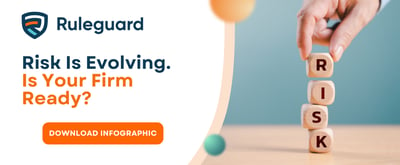Author: Richard Rivett - GRC Solutions Consultant
Topics: Risk, Compliance, Governance, Technology, Risk, Strategy
Regions and Regulators: Global, Europe, UK
Time to read: 4 minutes
TL:DR - Learn how to secure executive buy-in for GRC by linking compliance to business goals, risk reduction, and measurable strategic value at board level!
- Introduction
- Reframing GRC for the boardroom
- Making the conversation strategic
- Addressing leadership concerns
- Leadership must model engagement
- GRC is everyone's business
- Final thought
- Contact Ruleguard
How to Position Risk and Compliance as a Driver of Business Performance
In 1957, as the Space Race accelerated, NASA’s engineers faced a problem: no matter how advanced their rockets were, missions would fail without top-level alignment on priorities, risks, and resources. The launch of Sputnik by the Soviet Union jolted the United States into action. The response wasn’t just about building rockets faster, it was about creating NASA, an organisation designed to unify scattered research labs, defence agencies, and contractors under one strategic vision.
Before NASA, the Army, Navy, and Air Force all ran competing space programmes. This fragmented approach risked duplication, missed opportunities, and costly errors. When NASA was formally established in 1958, its first major tasks weren’t purely technological - they were about governance and coordination. Engineers could build brilliant hardware, but without senior leadership aligning resources, prioritising missions, and managing risks, the effort would have been chaotic. The Apollo programme’s success in 1969 wasn’t just a triumph of engineering, it was the result of clear leadership buy-in, structured oversight, and shared accountability across thousands of contractors and teams.
Modern organisations face a similar challenge with Governance, Risk and Compliance (GRC). Departments like audit, compliance, IT, and procurement may each manage risks well within their silos, but without executive-level alignment, gaps emerge. Just as NASA brought order to the early Space Race, a unified GRC strategy - backed by leadership - turns fragmented efforts into a coordinated, resilient system capable of achieving audacious goals.
Reframing GRC for the Boardroom
While GRC is a standing agenda item in most boardrooms, it’s often presented through a technical lens and often without the strategic framing needed to drive decision-making. When GRC is framed as a technical chore rather than a strategic enabler, it risks underinvestment - not because boards aren’t engaged - but because the data often lacks relevance to their priorities and is difficult to gather, collate, and present in a way that supports timely, informed decision-making. To transform risk and compliance into a source of competitive strength, you need to speak to the boardroom’s priorities - not operational minutiae.
Executives rarely get excited about workflows or dashboards. What captures their attention is how GRC helps them achieve resilience, agility, and insight. Resilience means the organisation can withstand disruption - whether regulatory, reputational, or operational. Agility ensures it can respond quickly to emerging risks or new regulations without losing momentum. Insight provides leadership with a clear view of risk trends so they can make smarter, faster decisions.
Take, for example, a financial services firm using GRC to detect a pattern of failed controls in a vendor. Spotting the issue early allowed them to intervene, avoiding a potential data breach and regulatory fallout. That isn’t just compliance - that’s strategic risk management in action.
Making the Conversation Strategic
When presenting GRC to senior leaders, avoid framing it through narrow metrics or technical language. Boards already own risk management, it is after all part of their mandate. The opportunity lies in helping them understand the nature of the risks and how best to mitigate them. Frame the conversation around business continuity, reputation protection, and decision-making speed. Executives want to know: How does this help us stay competitive? How does it safeguard what we’ve built?
Real incidents can sharpen their focus. A high-profile breach or a costly enforcement action at a peer company offers a natural opportunity to ask: “Could this happen to us? How would we respond if it did?” These questions make GRC urgent and relevant.
Don’t shy away from discussing the cost of delay. Every day spent relying on fragmented spreadsheets or outdated tools increases the risk of missed deadlines, versioning errors, or hidden vulnerabilities. Contrast that with the stability and confidence that modern GRC platforms bring automated processes, rapid escalation paths, and clear visibility across departments.
Addressing Leadership Concerns
Leaders may have valid reservations about adopting new technology: Will it be too complex? Will people actually use it? How will it integrate with our existing systems? These concerns should be acknowledged, not dismissed.
Choose platforms with intuitive interfaces and low-code or no-code configurability to make adoption straightforward. Highlight cross-functional use cases that show GRC’s value across the organisation. Demonstrate how modern systems integrate seamlessly with existing infrastructure, enhancing rather than replacing what’s already in place.
Position GRC not as “another piece of software,” but as the invisible infrastructure - like plumbing or wiring - that enables safe, scalable growth.
Leadership Must Model Engagement
Endorsement isn’t enough. Executives need to actively champion GRC adoption, set expectations, and reinforce its value across teams. When the board treats risk and compliance as central to strategy, the rest of the organisation follows suit.
Embedding GRC into company culture creates a shared sense of accountability. Issues get surfaced early, acted upon quickly, and used as learning opportunities. Over time, GRC evolves from a siloed responsibility to a shared organisational mindset.
GRC Is Everyone’s Business
Risk and compliance don’t stop at the risk or compliance team’s door. HR faces data privacy obligations, IT manages cyber risk, finance handles regulatory reporting, and procurement monitors third-party exposure. A unified GRC platform enables these teams to collaborate, share insights, and work from a single source of truth - turning GRC into a living, breathing part of decision-making.
Final Thought: From Risk Awareness to Strategic Advantage
Great leaders, from ship captains to space, explorers know that preparation and visibility make the difference between success and catastrophe. GRC is no different. Its value lies not only in avoiding fines or breaches but in creating the agility to seize opportunities and pivot faster than competitors when the market shifts.
By reframing GRC as a strategic enabler and engaging executives with stories, metrics, and relevance, you transform it from a compliance obligation into a source of confidence and competitive edge. When the board sees GRC as an ally in achieving its ambitions, investment stops being discretionary and becomes a strategic imperative.
Book a tailored discovery call
Ready to turn GRC into a board-level advantage?
Book a tailored discovery call with Ruleguard to see how leading firms unify risk and compliance, surface the insights executives care about, and stay audit-ready, without the spreadsheet sprawl.

About the Author














.jpg?width=400&height=166&name=shutterstock_2450801853%20(1).jpg)




.png?width=400&height=166&name=Compliance%20Monitoring%20White%20Paper%20(1).png)




















.jpg)

